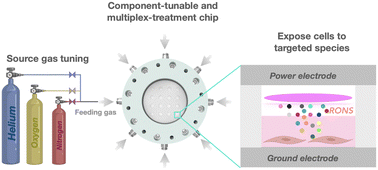A composition-tunable cold atmospheric plasma chip for multiplex-treatment of cells†
Abstract
Cold atmospheric plasma treatment promises a targeted cancer therapy due to its selectivity and specificity in killing tumor cells. However, the current plasma exposure devices produce diverse and coupled reactive species, impeding the investigation of the underlying plasma–anticancer mechanisms. Also, the limited mono-sample and mono-dosage treatment modality result in tedious and manual experimental tasks. Here, we propose a cold atmospheric plasma chip producing targeted species, delivering multiple dosages, and treating multiple cell lines in a single treatment. Three modules are integrated into the chip. The environment control module and multi-inlet gas-feed module coordinately ignite component-tunable and uniformly distributed plasma. The multi-sample holding module enables multiplex treatment: multi-sample and -dosage treatment with single radiation. By exposing the HepG2 cell line to nitrogen-feed plasmas, we prove the crucial role of nitrogen-based species in inhibiting cell growth and stimulating apoptosis. By loading four-type cell lines on our chip, we can identify the most vulnerable cell line for plasma oncotherapy. Simultaneously, three-level treatment dosages are imposed on the cells with single radiation to optimize the applicable treatment dosage for plasma oncotherapy. Our chip will broaden the design principles of plasma exposure devices, potentially help clarify plasma-induced anticancer mechanisms, and guide the clinical application of plasma-based oncotherapy.



 Please wait while we load your content...
Please wait while we load your content...